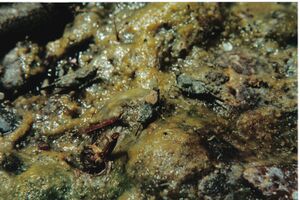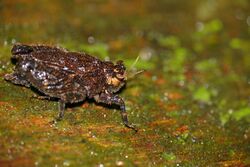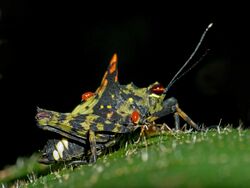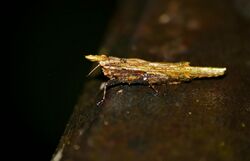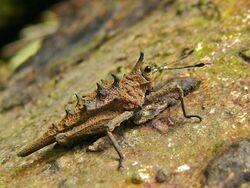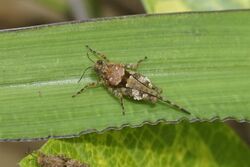Biology:Tetrigidae
| Tetrigidae | |
|---|---|
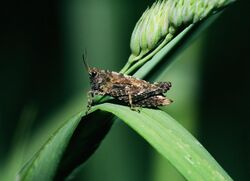
| |
| Tetrix species | |
| Scientific classification | |
| Domain: | Eukaryota |
| Kingdom: | Animalia |
| Phylum: | Arthropoda |
| Class: | Insecta |
| Order: | Orthoptera |
| Suborder: | Caelifera |
| Superfamily: | Tetrigoidea |
| Family: | Tetrigidae Rambur, 1838 |
| Subfamilies | |
Tetrigidae[1] is an ancient family in the order Orthoptera,[2] which also includes similar families such as crickets, grasshoppers, and their allies. Species within the Tetrigidae are variously called groundhoppers,[3] pygmy grasshoppers,[4] pygmy devils[5] or (mostly historical) "grouse locusts".[6]
Diagnostic characteristics
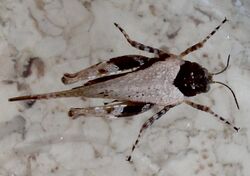
Tetrigidae are typically less than 20 mm in length and are recognizable by a long pronotum. This pronotum extends over the length of the abdomen, sometimes to the tip of the wings, and ends in a point.[4] In other Orthoptera, the pronotum is short and covers neither the abdomen nor the wings. Tetrigidae are generally cryptic in coloration.[7] Some species have enlarged pronota that mimic leaves, stones or twigs.[8][9] Other characteristics pygmy grasshoppers exhibit in comparison to other Orthoptera families are the lack of an arolium between the claws, the first thoracic sternite being modified into collar-like structure called sternomentum, a tarsal formula of 2-2-3, scaly fore wings, and developed hind wings.[10]
General biology
In temperate regions, Tetrigidae are generally found along streams and ponds, where they feed on algae and diatoms.[11] The North American species Paratettix aztecus and Paratettix mexicanus, for example, depend on aquatic primary production for between 80% and 100% of their diet.[12] Riparian species are capable of swimming on the surface of the water, and readily leap into the water when alarmed[9] Some species in the tribe Scelimenini are fully aquatic and capable of swimming underwater.[10][11]
The highest biodiversity of Tetrigidae is found in tropical forests.[10] Some tropical species are arboreal and live among mosses and lichens in tree buttresses or in the canopy,[11] while others live on the forest floor.[7]
Like other Orthoptera, Tetrigidae have a hemimetabolous development, in which eggs hatch into nymphs. Unlike other temperate Orthoptera, however, temperate Tetrigidae generally overwinter as adults.[4]
Some subfamilies within the Tetrigidae, such as the Batrachideinae, are sometimes elevated to family rank besides the Tetrigidae.
Arulenus miae is a pygmy grasshopper species from the tropical mountainous rainforests of the Philippines. The species was firstly discovered in Facebook post.[5]
Etymology
Origin of the name of the family is not completely clear as there are different sources on its etymology. The name may be derived from Latin tetricus or taetricus, meaning harsh, sour, severe.[13] The name may also originate from the earlier name 'Tettigidae', based on Tettix (synonym of Tetrix), which was preoccupied by Tettigidae (synonym of Cicadidae).[14] Because of the preoccupation by the cicadas' family name, the second 't' in 'tt' was changed into 'r', resulting in the word Tetrigidae.
Subfamilies and Genera
Approximately 2,000 species have been described; according to the Orthoptera Species File[15] the following genera are included:
Subfamily Batrachideinae
Auth.: Bolívar, 1887; selected genera:
- Batrachidea Serville, 1838
- Saussurella Bolívar, 1887
- Tettigidea Scudder, 1862
Subfamily Cladonotinae
Auth.: Bolívar, 1887; selected genera:
Tribe Cladonotini Bolívar, 1887[16]
- Cladonotus Saussure, 1862
- Deltonotus Hancock, 1904
- Piezotettix Bolívar, 1887
Tribe Choriphyllini Cadena-Castañeda & Silva, 2019[17]
- Choriphyllum Serville, 1838
- Phyllotettix Hancock, 1902
Tribe Valalyllini Deranja, Kasalo, Adžić, Franjević & Skejo, 2022[18]
- Lepocranus Devriese, 1991
- Valalyllum Deranja, Kasalo, Adžić, Franjević & Skejo, 2022
Tribe Xerophyllini Günther, 1979 SE Asia - selected genera:
- Potua Bolívar, 1887 (genus group)
- Xerophyllum Fairmaire, 1846
Tribe Unassigned
- Austrohancockia Günther, 1938
- Cota Bolívar, 1887
- Epitettix Hancock, 1907
- Nesotettix Holdhaus, 1909
Subfamily Lophotettiginae
Auth.: Hancock, 1909
- Lophotettix Hancock, 1909
- Phelene Bolívar, 1906
Subfamily Metrodorinae
Auth.: Bolívar, 1887; selected genera:
Tribe Amorphopini Günther, 1939
- Amorphopus Serville, 1838
Tribe Cleostratini Hancock, 1907
- Cleostratus (insect) Stål, 1877 (Philippines)
Tribe Clinophaestini Storozhenko, 2013
- Birmana Brunner von Wattenwyl, 1893
- Clinophaestus Storozhenko, 2013
Tribe Miriatrini Cadena-Castañeda & Cardona, 2015 (monotypic)
- Miriatra Bolívar, 1906
Tribe Ophiotettigini Tumbrinck & Skejo, 2017
- Ophiotettix Walker, 1871
- Uvarovithyrsus Storozhenko, 2016
Tribe Unassigned
- Bolivaritettix Günther, 1939
- Cleostratoides Storozhenko, 2013
- Crimisus (insect) Bolívar, 1887
- Hildegardia (insect) Günther, 1974
- Holocerus Bolívar, 1887
- Macromotettix Günther, 1939
- Mazarredia Bolívar, 1887
- Pseudoparatettix Günther, 1937
- Pseudoxistrella Liang, 1991
- Vaotettix Podgornaya, 1986
Subfamily Scelimeninae
Auth.: Hancock, 1907 Tribe Scelimenini Hancock, 1907; selected genera:
- Amphibotettix Hancock, 1906
- Austrohancockia Günther, 1938
- Bidentatettix Zheng, 1992
- Discotettix Costa, 1864
- Gavialidium Saussure, 1862
- Scelimena Serville, 1838
- Zhengitettix Liang, 1994
Subfamily Tetriginae
Auth.: Serville, 1838
Tribe Dinotettigini Günther, 1979
- Afrocriotettix Günther, 1938
- Dinotettix Bolívar, 1905
- Ibeotettix Rehn, 1930
- Lamellitettix Hancock, 1904
- Marshallacris Rehn, 1948
- Pseudamphinotus Günther, 1979
Tribe Tetrigini Serville, 1838
- Clinotettix Bei-Bienko, 1933
- Coptotettix Bolívar, 1887
- Euparatettix Hancock, 1904
- Exothotettix Zheng & Jiang, 1993
- Hydrotetrix Uvarov, 1926
- Paratettix Bolívar, 1887
- Tetrix Latreille, 1802 (synonym Depressotetrix Karaman, 1960)
- Thibron Rehn, 1939
Tribe unassigned:
- Aalatettix Zheng & Mao, 2002
- Alulatettix Liang, 1993
- Ankistropleuron Bruner, 1910
- Bannatettix Zheng, 1993
- Bienkotetrix Karaman, 1965
- Bufonides Bolívar, 1898
- Carolinotettix Willemse, 1951
- Coptottigia Bolívar, 1912
- Cranotettix Grant, 1955
- Ergatettix Kirby, 1914
- Flatocerus Liang & Zheng, 1984
- Formosatettix Tinkham, 1937
- Formosatettixoides Zheng, 1994
- Gibbotettix Zheng, 1992
- Hedotettix Bolívar, 1887
- Leptacrydium Chopard, 1945
- Macquillania Günther, 1972
- Micronotus Hancock, 1902
- Neocoptotettix Shishodia, 1984
- Neotettix Hancock, 1898
- Nomotettix Morse, 1894
- Ochetotettix Morse, 1900
- Oxyphyllum Hancock, 1909
- Phaesticus Uvarov, 1940
- Sciotettix Ichikawa, 2001
- Stenodorus Hancock, 1906
- Teredorus Hancock, 1907
- Tettiella Hancock, 1909
- Tettiellona Günther, 1979
- Uvarovitettix Bazyluk & Kis, 1960
- Xiaitettix Zheng & Liang, 1993
Subfamily Tripetalocerinae
Auth.: Bolívar, 1887
Tripetalocerinae was originally described by Bolívar in 1887[19] to gather all the Tetrigidae genera of the old world with widened antennae (e.g. Arulenus, Discotettix, Hirrius, Ophiotettix, Tripetalocera). This subfamily today includes only two species in two genera - Tripetalocera (with one species) from India and Borneo and Tripetaloceroides (with one species) from Vietnam and China . Members of the subfamily are characteristic within Tetrigidae by massive antennae built up of only eight segments (other Tetrigidae have usually 11-16, Batrachideinae 18-22).[20] Till recently,[20] the subfamily included two tribes - Tripetalocerini and Clinophaestini (including Clinophaestus and Birmana), but the later was moved to the subfamily Metrodorinae due to similarity to Ophiotettigini.[21]
- Tripetalocera - monotypic Tripetalocera ferruginea Westwood, 1834
- Tripetaloceroides Storozhenko, 2013 - monotypic Tripetaloceroides tonkinensis (Günther, 1938)
Subfamily unassigned
Criotettigini
Auth. Kevan, 1966
- Criotettix Bolívar, 1887
- Dasyleurotettix Rehn, 1904
Thoradontini
Auth. Kevan, 1966
- Eucriotettix Hebard, 1930
- Loxilobus Hancock, 1904
- Thoradonta Hancock, 1909
Subfamily and tribe unassigned
- Bolotettix Hancock, 1907
- Cyphotettix Rehn, 1952
- †Eozaentetrix Zessin, 2017
- Euloxilobus Sjöstedt, 1936
- Paramphinotus Zheng, 2004
- Peronotettix Rehn, 1952
- Phaesticus Uvarov, 1940 (synonym Flatocerus Liang & Zheng, 1984)
- Probolotettix Günther, 1939
- Pseudosystolederus Günther, 1939
- Syzygotettix Günther, 1938
- Tettitelum Hancock, 1915
- †Archaeotetrix Sharov, 1968
- †Prototetrix Sharov, 1968
References
- ↑ Rambur (1838) Faune entomologique de l'Andalousie 2:64
- ↑ Song, Hojun; Amédégnato, Christiane; Cigliano, Maria Marta; Desutter-Grandcolas, Laure; Heads, Sam W.; Huang, Yuan; Otte, Daniel; Whiting, Michael F. (2015-03-09). "300 million years of diversification: elucidating the patterns of orthopteran evolution based on comprehensive taxon and gene sampling". Cladistics 31 (6): 621–651. doi:10.1111/cla.12116. ISSN 0748-3007. PMID 34753270. http://sedici.unlp.edu.ar/handle/10915/108443.
- ↑ Ragge DR (1965). Grasshoppers, Crickets & Cockroaches of the British Isles. F Warne & Co, London. pp. 299.
- ↑ 4.0 4.1 4.2 Borror DJ, Tripplehorn CA, Johnson NF (1989) An Introduction to the Study of Insects, 6th edition. Harcourt Brace College Publishers. New York. pg 213
- ↑ 5.0 5.1 Skejo, Josip; Caballero, Joy Honezza S. (2016-01-21). "A hidden pygmy devil from the Philippines: Arulenus miae sp. nov. — a new species serendipitously discovered in an amateur Facebook post (Tetrigidae: Discotettiginae)". Zootaxa 4067 (3): 393. doi:10.11646/zootaxa.4067.3.7. ISSN 1175-5334. PMID 27395882.
- ↑ Imms AD, rev. Richards OW & Davies RG (1970) A General Textbook of Entomology 9th Ed. Methuen 886 pp.
- ↑ 7.0 7.1 Grimaldi D, Engel MS (2005) Evolution of the Insects. Cambridge University Press, Cambridge. pg 211
- ↑ Skejo, Josip (2017). Taxonomic revision of the pygmy devils (Tetrigidae: Discotettiginae) with online social media as a new tool for discovering hidden diversity. Zagreb: University of Zagreb, Faculty of Science, Department of Biology. pp. 1–246.
- ↑ 9.0 9.1 Preston-Mafham K (1990) Grasshoppers and Mantids of the World. Facts of File, New York. pg 32
- ↑ 10.0 10.1 10.2 Muhammad, Amira Aqilah; Tan, Ming Kai; Abdullah, Nurul Ashikin; Azirun, Mohammad Sofian; Bhaskar, Dhaneesh; Skejo, Josip (2018-09-25). "An annotated catalogue of the pygmy grasshoppers of the tribe Scelimenini Bolívar, 1887 (Orthoptera: Tetrigidae) with two new Scelimena species from the Malay Peninsula and Sumatra". Zootaxa 4485 (1): 1–70. doi:10.11646/zootaxa.4485.1.1. ISSN 1175-5334. PMID 30313773.
- ↑ 11.0 11.1 11.2 Resh VH, Cardé RT (2003) Encyclopedia of Insects. Academic Press, Amsterdam, pg 839
- ↑ Bastow, J. L.; Sabo, J. L.; Finlay, J. C.; Power, M. E. (2002). "A basal aquatic-terrestrial trophic link in rivers: algal subsidies via shore-dwelling grasshoppers". Oecologia 131: 261–268.
- ↑ "Family Tetrigidae - Pygmy Grasshoppers". http://bugguide.net/node/view/106.
- ↑ Buckton, George Bowdler (1890). Monograph of the British Cicadae or Tettigidae.. London: Macmillan & Co.. https://www.biodiversitylibrary.org/bibliography/9473.
- ↑ Orthoptera Species File (Version 5.0/5.0, retrieved 26 November 2018: checking incomplete)
- ↑ Bhaskar, Dhaneesh; Stermšek, Sara; Easa, P. S.; Franjević, Damjan; Skejo, Josip (2020-12-10). "Wide-nosed pygmy grasshoppers (Cladonotinae: Cladonotini, Xerophyllini) of India and Sri Lanka: catalogue with an identification key and description of a new species of the genus Tettilobus". Zootaxa 4894 (3): 474–500. doi:10.11646/zootaxa.4894.3.12. ISSN 1175-5334. PMID 33311079. http://dx.doi.org/10.11646/zootaxa.4894.3.12.
- ↑ Silva, Daniela Santos Martins; Cadena-Castañeda, Oscar J.; Pereira, Marcelo Ribeiro; De Domenico, Fernando Campos; Sperber, Carlos Frankl (2019-10-16). "Review of Lophotettix, the sole member of the subfamily Lophotettiginae Hancock, 1909 (Insecta: Orthoptera: Caelifera: Tetrigidae)". Zootaxa 4686 (3): 346–360. doi:10.11646/zootaxa.4686.3.2. ISSN 1175-5334. http://dx.doi.org/10.11646/zootaxa.4686.3.2.
- ↑ Deranja, Maks; Kasalo, Niko; Adžić, Karmela; Franjević, Damjan; Skejo, Josip (2022-07-01). "Lepocranus and Valalyllum gen. nov. (Orthoptera, Tetrigidae, Cladonotinae), endangered Malagasy dead-leaf-like grasshoppers". ZooKeys (1109): 1–15. doi:10.3897/zookeys.1109.85565. ISSN 1313-2970.
- ↑ Bolívar; Urrutia, Ignacio (1887). Essai sur les acridiens de la tribu des Tettigidae. Imprimerie C. Annoot-Braeckman. OCLC 42198873.
- ↑ 20.0 20.1 Storozhenko, Sergey Yu. (2013-10-03). "Review of the subfamily Tripetalocerinae Bolívar, 1887 (Orthoptera: Tetrigidae)" (in en). Zootaxa 3718 (2): 158–170. doi:10.11646/zootaxa.3718.2.4. ISSN 1175-5334. PMID 26258216.
- ↑ Tumbrinck, Josef; Skejo, Josip (2017). "Taxonomic and biogeographic revision of the New Guinean genus Ophiotettix Walker, 1871 (Tetrigidae: Metrodorinae: Ophiotettigini trib. nov.), with the descriptions of 33 new species". Biodiversity, Biogeography and Nature Conservation in Wallacea and New Guinea. Riga: Entomological Society of Latvia. pp. 525–580, figures 104–124. https://bib.irb.hr/datoteka/904156.Tumbrinck__Skejo_small.pdf.
External links
Wikidata ☰ Q768200 entry
 |

